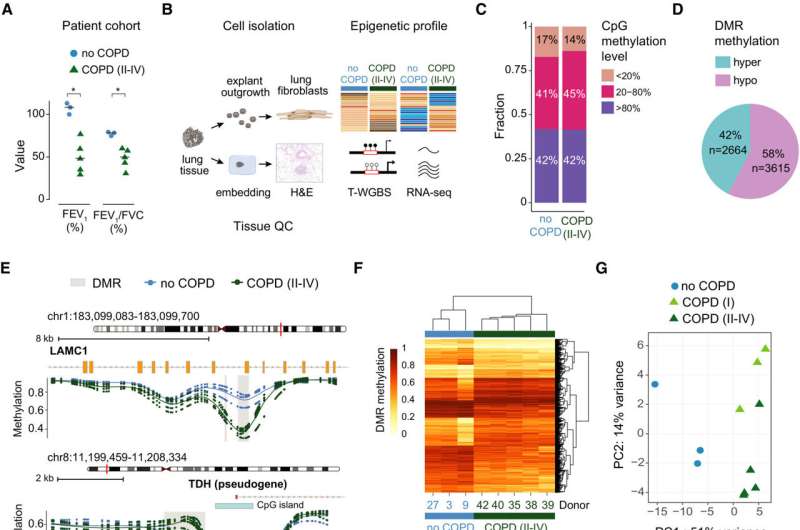This article has been reviewed according to Science X's editorial process and policies. Editors have highlighted the following attributes while ensuring the content's credibility:
fact-checked
peer-reviewed publication
trusted source
proofread
Epigenetic profiling identifies potential COPD treatment targets

Impaired function of lung fibroblast is considered causative for symptoms of the incurable lung disease COPD (Chronic Obstructive Pulmonary Disease). Using high-resolution epigenetic profiling, German and British scientists have now identified potential targets for COPD treatment. The team detected early epigenetic changes in the genome of COPD fibroblasts, providing new insights into the disease pathogenesis and potential therapeutic avenues.
COPD, affecting approximately 600 million people globally, is characterized by chronic inflammation, progressive airway narrowing, and alveolar destruction. Despite its global prevalence, the molecular mechanisms driving lung fibroblast dysfunction in COPD have remained elusive.
"For example, we know that smoking—the main risk factor for COPD—strongly modifies the epigenome of lung cells. However, we do not yet know which epigenetic changes occur specifically in lung fibroblasts during the course of the disease, and how these changes trigger aberrant signaling pathways that drive the impaired functions of fibroblasts in COPD," says Maria Llamazares-Prada from the German Cancer Research Center (DKFZ), one of the first authors of the current study.
Changes in cellular programs are controlled by a variety of epigenetic modifications. These chemical marks influence which genes are read and which are not. The best studied epigenetic mechanism is the attachment of methyl groups to DNA. Methylation changes in COPD have been studied previously, but mostly in mixed cell populations.
Together with colleagues from the University of Cardiff, the Translational Lung Research Center, Boehringer Ingelheim and the BioMedX Institute in Heidelberg, Uwe Schwartz, Llamazares and colleagues have now analyzed for the first time the methylome of isolated COPD fibroblasts at high resolution across different disease stages.
The researchers found that significant methylation changes occur early in the disease, particularly in regulatory regions of the genome. Proteins that activate or inhibit transcription bind to these altered regions, potentially affecting the expression of several genes.
Crucially, the team identified that regions with changed methylation patterns contain binding sites for transcription factors TCF21 and FOSL2/FRA2, which regulate key fibroblast processes associated with COPD. This discovery, combined with the integration of DNA methylation and gene expression data, led to the selection of 110 candidate genes that may regulate these changes in COPD fibroblasts.
Senior author, Renata Z. Jurkowska, Cardiff University (UK), stated, "Our aim was to support the development of new diagnostic strategies for early COPD and the rational selection of targets with potential disease-modifying activities. Further research is needed to pinpoint the target genes of the identified regulators in lung fibroblasts and their specific role in disease development."
The findings open a new window into understanding the epigenetic underpinnings of COPD and may lead to innovative treatment approaches for this incurable disease.
The study is published in The EMBO Journal.
More information: Uwe Schwartz et al, High‐resolution transcriptomic and epigenetic profiling identifies novel regulators of COPD, The EMBO Journal (2023). DOI: 10.15252/embj.2022111272



















